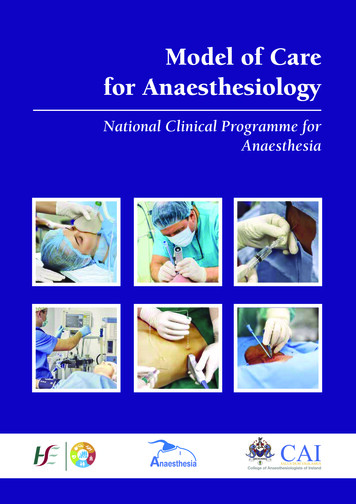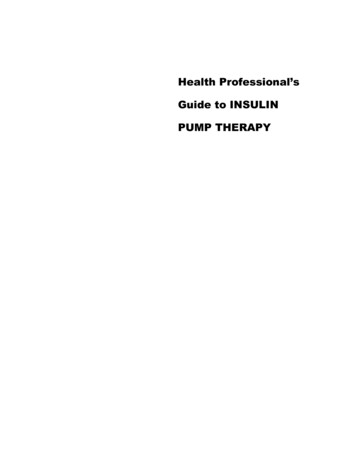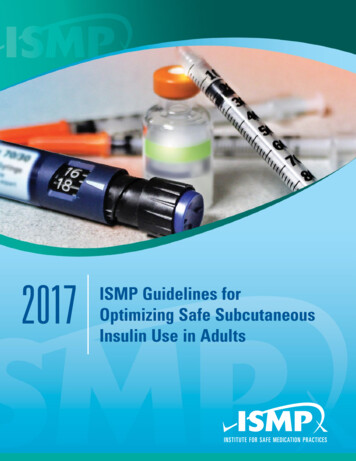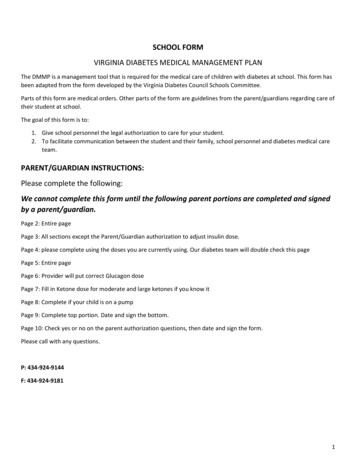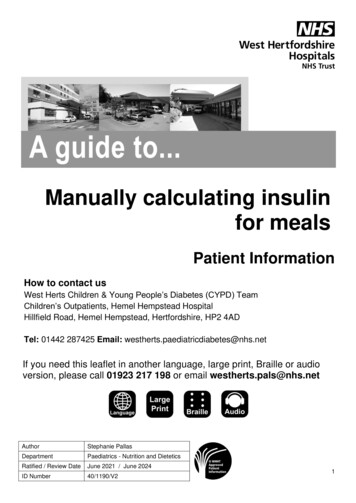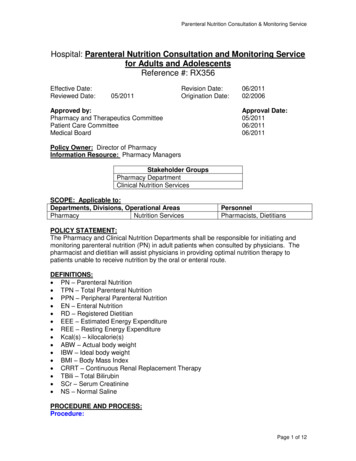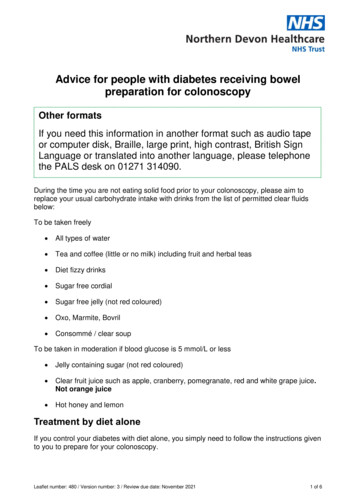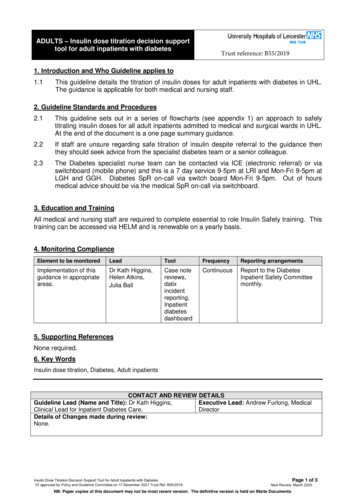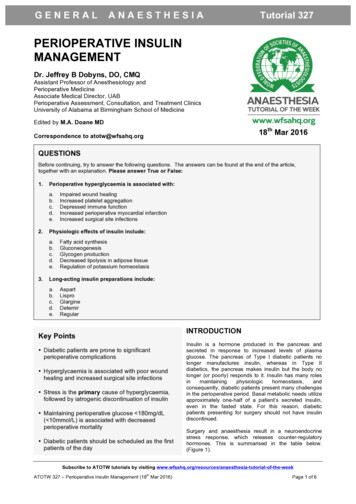
Transcription
GENERALANAESTHESIATutorial 327PERIOPERATIVE INSULINMANAGEMENTDr. Jeffrey B Dobyns, DO, CMQAssistant Professor of Anesthesiology andPerioperative MedicineAssociate Medical Director, UABPerioperative Assessment, Consultation, and Treatment ClinicsUniversity of Alabama at Birmingham School of MedicineEdited by M.A. Doane MD18th Mar 2016Correspondence to atotw@wfsahq.orgQUESTIONSBefore continuing, try to answer the following questions. The answers can be found at the end of the article,together with an explanation. Please answer True or False:1.Perioperative hyperglycaemia is associated with:a.b.c.d.e.2.Physiologic effects of insulin include:a.b.c.d.e.3.Impaired wound healingIncreased platelet aggregationDepressed immune functionIncreased perioperative myocardial infarctionIncreased surgical site infectionsFatty acid synthesisGluconeogenesisGlycogen productionDecreased lipolysis in adipose tissueRegulation of potassium homeostasisLong-acting insulin preparations arINTRODUCTIONKey Points Diabetic patients are prone to significantperioperative complications Hyperglycaemia is associated with poor woundhealing and increased surgical site infections Stress is the primary cause of hyperglycaemia,followed by iatrogenic discontinuation of insulin Maintaining perioperative glucose 180mg/dL( 10mmol/L) is associated with decreasedperioperative mortality Diabetic patients should be scheduled as the firstpatients of the dayInsulin is a hormone produced in the pancreas andsecreted in response to increased levels of plasmaglucose. The pancreas of Type I diabetic patients nolonger manufactures insulin, whereas in Type IIdiabetics, the pancreas makes insulin but the body nolonger (or poorly) responds to it. Insulin has many uently, diabetic patients present many challengesin the perioperative period. Basal metabolic needs utilizeapproximately one-half of a patient’s secreted insulin,even in the fasted state. For this reason, diabeticpatients presenting for surgery should not have insulindiscontinued.Surgery and anaesthesia result in a neuroendocrinestress response, which releases counter-regulatoryhormones. This is summarised in the table below.(Figure 1).Subscribe to ATOTW tutorials by visiting he-weekthATOTW 327 – Perioperative Insulin Management (18 Mar 2016)Page 1 of 6
Neuroendocrine stress response to surgeryIncreased plasma cortisol levelsInsulin resistanceIncreased hepatic breakdown of glycogenIncreased gluconeogenesisImpaired pancreatic insulin secretionIncreased fat and protein catabolismPotential for hyperglycaemia and ketosisFigure 1: Summary of themain neuroendocrineresponses to surgeryInsulin has multiple physiologic effects; some excitatory (stimulation of glucose uptake and lipid synthesis), and others1inhibitory (inhibition of lipolysis, proteolysis, glycogenolysis, gluconeogenesis, and ketogenesis). Whether the effect isexcitatory or inhibitory depends on the target tissue.One of the most commonly recognized effects of insulin is to decrease the concentration of glucose in the blood.Hyper and hypo glycaemia are both associated with numerous adverse perioperative events (Figure 2). In 2012, a studypublished by the NICE-SUGAR study group demonstrated an increase in mortality in critically ill patients with moderate2to severe hypoglycaemia, particularly in the setting of distributive shock .HyperglycaemiaHypoglycaemia Immune system inhibition and increased surgical siteinfection Impaired wound healing Increased perioperative myocardial infarction Worsened neurologic outcomes Increased duration of ventilator dependence Increased risk of perioperative death Impaired autonomic functionAltered blood flow and compositionWhite blood cell activationVasoconstrictionRelease of inflammatory mediators and cytokinesQT prolongation, with a propensity to fatal arrhythmiasIncreased mortalityFigure 2: Adverse events associated with hyper- and hypo-glycaemiaTYPES OF INSULINThere are numerous ways to describe the different types of insulin; Function (prandial vs basal) Biochemical structure (analog, human, porcine) Duration of action (short-acting, long-acting, fixed combination)FunctionBasal insulin is commonly a long-acting preparation, designed to imitate background insulin secretion, keeping bloodsugar levels consistent when patients are not eating. It does not adequately cover glucose spikes after meals. Prandialinsulin may be a rapid or short-acting preparation, designed to mimic the insulin surge that physiologically occurs withingestion of a meal. Prandial insulin is taken more often during the day, preceding a meal or in response to point-of-careglucose determinations.Biochemical StructureThere are two types of insulin structures: recombinant human insulin and analog insulin. Recombinant human insulinsare essentially identical in structure to the native insulin produced in the body. Analog insulins are similar in structure buthave minor modifications, which allow for rapid onset of action or peakless effect. While analogs cost more, theygenerally cause less hypoglycaemia and weight gain. Most diabetic patients in the US today use analog insulin.Porcine and bovine insulins are older, animal-derived, preparations that are seldom used in current practice. Many areout-of-production.Duration of actionRapid-acting prandial insulin analogues include lispro, aspart, and glulisine. They are administered just prior to a mealand have an onset of action within 15 to 30 minutes. Their duration of action is 3-6 hours. The peak effect is reached with15 to 75 minutes. These preparations are very useful for perioperative use in rapid correction of hyperglycaemia.Short-acting prandial insulin, such as regular insulin, is a human recombinant DNA preparation with an onset of action of30 to 60 minutes, and a peak effect at 2 to 3 hours. The duration of action is between 3 and 8 hours.NPH (neutral protamine Hagedorn or Isophane insulin) is an intermediate-acting insulin that does peak in activity, andcan therefore cause hypoglycaemia in a fasted patient. Intermediate acting insulins, like NPH or a combination insulin(such as fixed-combination 70/30 preparations), are not to be treated as basal insulins, and therefore necessitateperioperative dose adjustment.Long-acting basal insulin analogue preparations such as detemir and glargine are dosed 1 to 2 times daily and areSubscribe to ATOTW tutorials by visiting he-weekthATOTW 327 – Perioperative Insulin Management (18 Mar 2016)Page 2 of 6
considered “peakless,” in that there is no discrete peak of activity (Figure 3). Consequently, they have a low associationwith hypoglycaemic episodes.Insulin degludec is an ultra-long acting analogue with a duration of action of at least 42 hours, and offers daily, everyother day, or three times weekly dosing. In the BEGIN Basal-Bolus Type 1 Trial, degludec was found to be non-inferior to3glargine when used as basal insulin and may have less associated risk of nocturnal hypoglycaemia . Presently, it isapproved for use in Europe but not the US.Note: The generic names of the various Insulin preparations are used here. It will be valuable to familiariseyourself with local brand names, as patients often only know them by these.Figure 3: Insulin ProfilesReproduced with permission of Leslie DeGroot, MD, Editor-in-Chief, Endotext.org from:Hirsch, IB, Skyler, JS. The Management of Type 1 Diabetes. www.endotext.org. Version of December 18, 2015, published by MDTEXT.COM, INC, South Dartmouth, MA 02748.PERIOPERATIVE MANAGEMENTHow is insulin dosed?1,2Diabetic patients frequently take a long-acting, basal, insulin preparation (such as glargine, detemir or degludec) .These formulations are peakless and maintain a constant level of insulin to prevent ketosis or hyperosmolality. Basal4insulin will not cause hypoglycaemia if a meal is skipped , and should therefore be continued perioperatively at theirnormal dose. If a patient has a history of morning hypoglycaemia, the dose can be reduced by 20%.Prandial insulin is usually a rapid-acting analog preparation (such as lispro, aspart or glulisine) which is injected prior to ameal. It reduces blood sugar within 15-25 minutes after injection, remains active for only three or four hours, and closelymatching the normal surge of insulin secreted after a meal. (Figure 4)Insulin pumps are portable devices that provide continuous subcutaneous insulin infusion. It uses an ultra-rapid-actinginsulin continuously as a basal insulin and can be bolused prior to meals. A majority of patients can have their pumpcontinued intraoperatively, but this decision is practitioner-dependent. Recommendations are to restrict pump use to4surgical procedures less than 2 hours . For longer procedures, the pump should be discontinued and replaced with anintravenous insulin lisine Regular NPH BasalGlargine Detemir Degludec OnsetPeak EffectRapid Acting Analog15-30 min30-75 min15-30 min30-75 min15-30 min30-75 minShort Acting30-60 min2-3 hoursIntermediate Acting2-4 hours6-10 hoursLong Acting3-4 hourspeaklessessentially3-4 hourspeakless30-90 minpeaklessDurationContinueHold3-6 hours3-6 hours3-6 hours 3-8 hours 10-18 hoursSee text18-24 hours 14-24 hours 40 hours See textFigure 4: Table showing insulin characteristics & preoperative recommendationsSubscribe to ATOTW tutorials by visiting he-weekthATOTW 327 – Perioperative Insulin Management (18 Mar 2016)Page 3 of 6
Why should insulin be continued when the patient is fasted?Patients require a constant source of insulin (whether or not they are diabetic), and discontinuing or decreasing insulinfor fear of hypoglycaemia is not appropriate.While insulin inhibits both gluconeogenesis and conversion of glycogen to glucose, it also inhibits degradation of fats tofatty acids and of fatty acids to ketones. Inadequate insulin dosing can lead to uncontrolled hyperglycaemia and even5ketoacidosis, which is why long-acting insulin must be continued, even in a fasting state .Perioperative Glucose TargetThe Normoglycaemia in Intensive Care Evaluation—Survival using Glucose Algorithm Regulation (NICE-SUGAR) Study,is a large, international, randomized trial published in 2009. The study concluded that a blood glucose target of 1806mg/dL ( 10mmol/L) resulted in lower mortality than a more restrictive target of 81-108 mg/dL(4.5-6mmol/L) . Although aspecific glucose target remains unclear, most published guidelines advocate for glucose levels between 140-180mg/dL(7.8-10mmol/L).Preoperative Insulin Dosing and Dosing AdjustmentsType I diabetic patients using long-acting insulins, such as glargine, should continue these as normal, when fasting. Ifthe patient is prone to morning hypoglycaemia, the dose can be reduced by 20%. For reasons stated above, this doseshould not be discontinued. Rapid acting insulins, such as aspart, should be held the morning of surgery. If theirmorning glucose is greater than 200mg/dL (11.1mmol/L), they may adjust the dose based on their prescribed slidingscale.Type II diabetic patients can continue their basal insulin and maintain their insulin pump. Rapid-acting insulins should beheld the morning of surgery. Patients who take intermediate-acting insulins, such as NPH, should take their usual doseon the evening prior to surgery. If they will be skipping their evening meal, the dose should be reduced by 25%. On the5morning of surgery, they should take half of their scheduled dose .Patients taking premixed insulins or fixed-combination insulins are more of a challenge. Premixed insulins (NPH 70/30,75/25, 50/50) are a combination of intermediate-acting insulin and either fast or short-acting insulin (effectively a basal5and prandial combination). Their perioperative use is not ideal. There are three options in this situation :Option 1. Discontinue the premixed insulin and switch to a regimen that includes long-acting insulin. This can be done bysubstituting a long-acting analog, such as glargine, in place of the night time dose of 70/30. A quick formula forconversion is to add all the premixed insulin doses and give half as basal insulin the night prior to surgery.Option 2. Adjust the dose of premixed insulin. It may not be feasible or economical to change the patient’s premixedinsulin just before surgery. In these situations, the patient can take ½ - ¾ of the morning dose, followed byadministration of a dextrose-containing intravenous fluid and frequent blood glucose checks.Option 3. Simply skip the morning dose of premixed insulin entirely and have the patient present to the preoperativearea early and have insulin dosed there based upon point-of-care values.Correction doses of insulin to treat hyperglycaemia can be given subcutaneously; with a rapid-acting formulation such aslispro or aspart. There are several “off-the-cuff” formulas for determining the amount of correction insulin to administer,such as 1-4 units of rapid-acting insulin for every 50 mg/dL (2.8mmol/L) of intended glucose reduction, or the “Rule of7,81800” (Figure 5) . Care must be taken when administering multiple doses of subcutaneous insulin to avoid hastilystacking them and causing a subsequent hypoglycaemia. Intravenous regular insulin can also be used, but it peaks4within minutes, has a duration of action of 30-40 minutes, which may result in rapid and wide swings in blood glucose .Asking the patient how much correction insulin they take for a given glucose level is a simple and effective means ofdose determination.The 1800 Rule allows an estimation of glucose reduction in response to 1 unit of insulin. As anexample, assume a patient takes a total daily dose of insulin of 50 units.Correction Factor 1800 Total Daily Insulin Dose1800 50 36mg/dL(100 50 2mmol/L)Since these are estimates, it would be reasonable to assume that 1 unit of insulin would beexpected to reduce glucose by 36-40 mg/dl (2-2.4mmol/L).If a patient has a glucose level of 385mg/dL (21.4mmol/L), it would be reasonable to administer4-5 units of insulin, with the expectation it would reduce the glucose to 200 mg/dl (11.1mmol/L)Figure 5: The “1800” RuleSubscribe to ATOTW tutorials by visiting he-weekthATOTW 327 – Perioperative Insulin Management (18 Mar 2016)Page 4 of 6
Intraoperative managementIntraoperative glucose control will be most effective with an intravenous insulin infusion. Subcutaneously administeredinsulin is poorly absorbed in the perioperative setting of hypothermia or peripheral vasoconstriction. A study published in2009 found that intraoperative insulin infusion was associated with a reduction in perioperative myocardial infarction in9patients undergoing vascular surgery . Check with your institution regarding protocols that may already be in place.Postoperative managementGlucose levels should be checked on arrival to the Post-Anaesthesia Recovery Unit (PARU), and hyperglycaemiatreated with rapid or short-acting insulin. Correction with insulin in the PARU should be administered intravenously.Many of the physiologic effects of surgery and anaesthesia, such as peripheral vasoconstriction or hypothermia, maymake subcutaneously administered insulin absorption unpredictable. Patients who have undergone major surgicalprocedures, such as CABG or large abdominal procedures, may benefit from having intraoperative insulin infusionscontinued in the postoperative phase. Infusion rates can be adjusted and correction insulin administered based onfrequent glucose determinations. Patients who will be without oral intake should be managed with insulin infusions andmay also necessitate simultaneous dextrose infusion. Once it becomes apparent that oral intake will be tolerated, thepatient can be transitioned from the insulin infusion to subcutaneous insulin. Since intravenous regular insulin has ashort half-life, the first dose of subcutaneous insulin should be given prior to discontinuing the infusion. Subcutaneous11short- or rapid-acting insulin should be given 1-2 hours before discontinuing an infusion . When intermediate- or longacting insulin is to be administered, it should be given 2-3 hours prior to infusion discontinuation.Patients who have undergone minor, or outpatient, procedures can resume their usual insulin use once normal eatingand drinking is tolerated. They should be made aware that some medications administered intraoperatively (such asdexamethasone) and postoperative pain may result in higher than usual glucose readings. For patients who wereadministered insulin intraoperatively, or in PARU, the risk of hypoglycaemia subsides within 1.5 hours after receivingsubcutaneous rapid-acting insulin and within 3-4 hours for subcutaneous short-acting insulin (regular insulin). In these12patients, a longer period of observation in PARU may be beneficial prior to discharge .SUMMARY Perioperative insulin management can be challenging, but with the introduction ofpeakless insulin analogs, it is becoming less so. Diabetic patients should be scheduled as the first patient of the day, or as early aspossible to minimize disruption of normal insulin dosing schedules. Effective perioperative insulin management results in improved surgical outcomes.Subscribe to ATOTW tutorials by visiting he-weekthATOTW 327 – Perioperative Insulin Management (18 Mar 2016)Page 5 of 6
ANSWERS TO QUESTIONS1.a. True.b. True.c. True.d. True.e. True. Perioperative hyperglycaemia is associated with all of these, as well as worsened neurologic outcomes10and an increased risk of death .2.a. True. Insulin plays a pivotal role in fatty acid synthesis.b. False. Gluconeogenesis is the production of glucose from stored sources and results in an increase in bloodglucose levels. Insulin is associated with mediating glucose storage as glycogen and a decrease in bloodglucose levels.c. True. Insulin is a potent stimulator of glycogen production in the liver.d. True. Insulin decreases lipolysis in adipose tissue and reduces ketosis.e. True. Insulin regulates the movement of potassium from the extracellular to intracellular environment via thesodium potassium ATPase.3.a.b.c.d.e.False. Aspart is a rapid-acting analog, with an onset of 5-15 mins and duration of 3-5 hrs.False. Lispro is a rapid-acting analog with an onset of 5-15 mins and duration of 3-5 hrs.True. Glargine is a long-acting analog with an onset of 2-4 hrs and duration of 20-24 hrs.True. Detemir is a long-acting analog with an onset of 2-4 hrs and duration of 16-20 hrs.False. Regular is a short-acting human insulin with an onset of 30-60 mins and duration of 5-8 hrs.REFERENCES1.Sonksen P, Sonksen J. Insulin: understanding its action in health and disease. British Journal of Anaesthesia.2000;85(1):69-79.2. Hypoglycaemia and risk of death in critically ill patients. New England Journal of Medicine 2012;367(12):1108-183. Heller S, Buse J, Fisher M, Garg S, Marre M, Merker L, et al. Insulin degludec, an ultra-longacting basal insulin,versus insulin glargine in basal-bolus treatment with mealtime insulin aspart in type 1 diabetes (BEGIN Basal-BolusType 1): a phase 3, randomised, open-label, treat-to-target non-inferiority trial. Lancet (London, England).2012;379(9825):1489-97.4. Vann MA. Perioperative management of ambulatory surgical patients with diabetes mellitus. Current opinion inanaesthesiology. 2009;22(6):718-24.5. Dobri G, Lansang M. How should we manage insulin therapy before surgery? CCJM. 2013;80(11):702-4.6. Intensive versus Conventional Glucose Control in Critically Ill Patients. New England Journal of Medicine.2009;360(13):1283-97.7. Inzucchi SE. Clinical practice. Management of hyperglycemia in the hospital setting. The New England journal ofmedicine. 2006;355(18):1903-11.8. Rhodes ET, Ferrari LR, Wolfsdorf JI. Perioperative management of pediatric surgical patients with diabetes mellitus.Anesthesia and analgesia. 2005;101(4):986-99, table of contents.9. Subramaniam B, Panzica PJ, Novack V, Mahmood F, Matyal R, Mitchell JD, et al. Continuous perioperative insulininfusion decreases major cardiovascular events in patients undergoing vascular surgery: a prospective, randomizedtrial. Anesthesiology. 2009;110(5):970-7.10. Kotagal M, Symons RG, Hirsch IB, Umpierrez GE, Dellinger EP, Farrokhi ET, et al. Perioperative hyperglycemia andrisk of adverse events among patients with and without diabetes. Annals of surgery. 2015;261(1):97-103.11. Khan, NA, Ghali, WA, Cagliero, E. Perioperative management of blood glucose in adults with diabetes mellitus. In:UpToDate. Post, TW (Ed), UpToDate, Waltham, MA, 2016.12. Joshi GP, Chung F, Vann MA, Ahmad S, Gan TJ, Goulson DT, et al. Society for Ambulatory Anesthesia consensusstatement on perioperative blood glucose management in diabetic patients undergoing ambulatory surgery.Anesthesia and analgesia. 2010;111(6):1378-87.This work is licensed under the Creative Commons Attribution-Noncommercial 3.0 Unported License. To view a copy ofthis license, visit cribe to ATOTW tutorials by visiting he-weekthATOTW 327 – Perioperative Insulin Management (18 Mar 2016)Page 6 of 6
Short-acting prandial insulin, such as regular insulin, is a human recombinant DNA preparation with an onset of action of 30 to 60 minutes, and a peak effect at 2 to 3 hours. The duration of action is between 3 and 8 hours. NPH (neutral protamine Hagedorn or Isophane insulin) is an intermediate-acting insulin that does peak in activity, and

